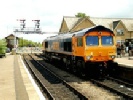Archive Section




By Richard Tomlinson
On a sunny morning, nine members travelled from West Yorkshire and London and met at Newcastle Central Station. It was 11:35 and an early lunch was on the agenda before the journey to Lynemouth. Whilst we were renewing friendships, eating and enjoying a drink, we suddenly noticed the clock was showing 12:15 and our mini-
We arrived at the smelter's security gate some 25 minutes later. Mr. Eric Fear met us and escorted us to the Conference room where we were shown a short video about Alcan, followed by a question and answer session. Our guide, Mr. Fear, is the Training & Safety Manager and has 28 years service with British Alcan, he explained that the main headquarters for Alcan is in Montreal.
Alcan's policy is to have team leaders, there are no supervisors on site and there is a low turnover of the workforce is very highly skilled. The site operates 365 days a year.
The Lynemouth Smelter complex comprises three principal units:
- The Alcan port and storage area at Blyth, where two of the products needed for smelting are imported. Bauxite from South America travels to Ireland where it is made into Alumina by a chemical process. It is then shipped to Blyth. The other basic material required is calcined petroleum coke, imported from the U.S.A. Both materials arrive in ships of 20,000 tonnes and are unloaded through a pneumatic suction unloader, via an enclosed conveyor system, into 7,000 & 15,000 tonne storage silos. The Alumina is transported from Blyth in specially designed rail wagons to the Lynemouth, Lochaber and Kinlochleven smelters. The coke is taken by road to the Lynemouth carbon plant to produce anodes for both the Lynemouth and Lochaber smelters;
- A 390 Megawatt power station, using one million tonnes of imported coal each year;
- The aluminium smelter with a rated annual output of 200,000 tonnes.
The anode blocks produced at Lynemouth are made with carbon that has reached temperatures of 250C in a mixer weighing 3/4 tonne. It turns out blocks at the rate of one every three minutes. They are then transported to the gas-
We were shown the pot rooms the size of which is equivalent to twenty-
To make two tonnes of aluminium it takes: sodium carbon; alumina; oxdite and four tonnes of bauxite.
After the pot rooms we moved to the casting plant where there are five holding furnaces and two direct-
Aluminium can be made into 300 different alloys, depending upon what the customer wants. Ingots are produced in 8 and 16 tonne sizes and these are removed from the casting pit by 20ft high cranes. After inspection they are processed ready for dispatch. 90% go by rail to Rogerstone Mill in Wales, the remaining 10*% by road to Norf, near Dusseldorf in Germany.
Alcan in the UK:
Lochaber smelter in Scotland was built in 1927 and extensively modernised in 1981. It is now one of the most efficient plants in the world with an annual output of 40,000 tonnes.
Kinlochleven smelter in Scotland is one of the oldest (1907) and smallest aluminium smelters in the world with an annual capacity of 11,000 tonnes. Its output is of high purity and used in foundry applications.
A rolling mill in Wales, recycling in Warrington and U.K. Alucans (capacity of 55,000 tonnes of can sheet ingots per year) are three further plants. Alcan Chemicals in Burntisiand, Fife, are sole producers of speciality oxides and hydroxides used in a variety of applications, such as fire-
We departed at 16:05 for Newcastle and the 16:50 home.
Thanks to Eric Fear and British Alcan for a fascinating and very informative tour.